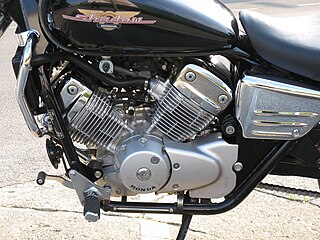
A V-twin engine, also called a V2 engine, is a two-cylinder piston engine where the cylinders are arranged in a V configuration and share a common crankshaft.
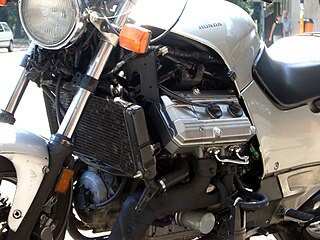
A V4 engine is a four-cylinder piston engine where the cylinders share a common crankshaft and are arranged in a V configuration.

A flat-twin engine is a two-cylinder internal combustion engine with the cylinders on opposite sides of the crankshaft. The most common type of flat-twin engine is the boxer-twin engine, where both pistons move inwards and outwards at the same time.

A flat-four engine, also known as a horizontally opposed-four engine or boxer engine, is a four-cylinder piston engine with two banks of cylinders lying on opposite sides of a common crankshaft. The most common type of flat-four engine is the boxer-four engine, each pair of opposed pistons moves inwards and outwards at the same time.

A straight-twin engine, also known as an inline-twin, vertical-twin, or parallel-twin, is a two-cylinder piston engine whose cylinders are arranged in a line along a common crankshaft.

A straight-four engine is a four-cylinder piston engine where cylinders are arranged in a line along a common crankshaft.

Front-wheel drive (FWD) is a form of engine and transmission layout used in motor vehicles, in which the engine drives the front wheels only. Most modern front-wheel-drive vehicles feature a transverse engine, rather than the conventional longitudinal engine arrangement generally found in rear-wheel-drive and four-wheel-drive vehicles.

In automotive design, a front-engine, front-wheel-drive (FWD) layout, or FF layout, places both the internal combustion engine and driven roadwheels at the front of the vehicle.

The Ford D3 platform is an automobile platform assembled by Ford Motor Company. In production between the 2005 and 2019 model years, the D3 platform is the fifteenth generation of full-size cars produced by Ford in North America. Marking the adoption of unibody chassis construction, a transverse engine configuration, front-wheel drive, all-wheel drive, and the lack of a V8 engine, the D3 platform is derived from the 1998-2016 Volvo P2 architecture. Since 2008, the related D4 platform has served as a basis for crossover SUVs.

The Land Rover Freelander is a series of four-wheel-drive vehicles that was manufactured and marketed by Land Rover from 1997 to 2015. Initially a compact SUV built on a body-on-frame chassis, the second generation model, sold from 2007 to 2015 in North America and the Middle East as the LR2 and in Europe as the Freelander 2, transitioned to a car-based platform which placed it into the compact crossover SUV class, and was developed alongside the Volvo XC60, the Volvo S80 and the third generation Ford Mondeo. The name 'Freelander' is derived from the combination of 'Freedom' and 'Lander'.

A transaxle is a single mechanical device which combines the functions of an automobile's transmission, axle, and differential into one integrated assembly. It can be produced in both manual and automatic versions.
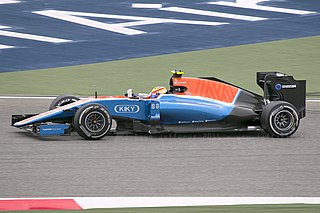
In automotive engineering, a mid-engine layout describes the placement of an automobile engine in front of the rear-wheel axles, but behind the front axle.

The Ferrari Mondial is a mid-engined, V8, grand tourer manufactured and marketed by Ferrari between 1980 and 1993 – with styling by Pininfarina and bodywork by Carrozzeria Scaglietti.
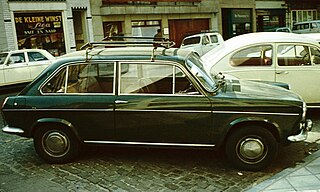
The Autobianchi Primula is a supermini economy car manufactured between 1964 and 1970 by the Italian automaker Autobianchi, partly owned by and later a subsidiary of the Fiat Group. The Primula was a prototype for Fiat's rack and pinion steering and is widely known for its innovative Dante Giacosa-designed front-wheel drive, transverse engine layout — that would be later popularized by the Fiat 128 to ultimately become an industry-standard front drive layout.

In automotive engineering, a longitudinal engine is an internal combustion engine in which the crankshaft is oriented along the long axis of the vehicle, from front to back.

A motorcycle engine is an engine that powers a motorcycle. Motorcycle engines are typically two-stroke or four-stroke internal combustion engines, but other engine types, such as Wankels and electric motors, have been used.

The BMC E-series engine is a line of straight-4 and straight-6 overhead camshaft automobile petrol engines from the British Motor Corporation (BMC). It displaced 1.5 L or 1.8 L in four-cylinder form, and 2.2 L or 2.6 L as a six-cylinder. The company's native United Kingdom market did not use the 2.6 L version, which was used in vehicles of Australian and South African manufacture. Although designed when the parent company was BMC, by the time the engine was launched the company had become British Leyland (BL), and so the engine is commonly referred to as the British Leyland E-series engine.

Dante Giacosa was an Italian automobile designer and engineer responsible for a range of Italian automobile designs — and for refining the front-wheel drive layout to an industry-standard configuration.
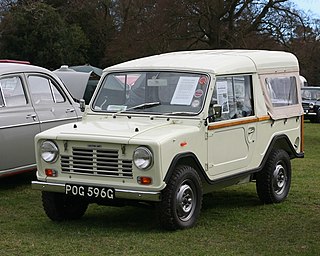
The Austin Ant is a small four-wheel drive vehicle that was designed by Sir Alec Issigonis for the motor manufacturer Austin. Although the Ant is widely regarded as a military vehicle, some sources suggest it was conceived with civilian use in mind as well. In its military role, it was a potential successor to the military version of an earlier Issigonis design, the Mini Moke.

The B8444S is an automobile V8 engine developed by Yamaha Motor Corporation for Volvo Cars. It was built in Japan and based on Volvo designs.






















